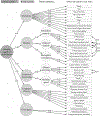Measurement and Structure of Cognition in the Longitudinal Aging Study in India-Diagnostic Assessment of Dementia
- PMID: 32815599
- PMCID: PMC7513554
- DOI: 10.1111/jgs.16738
Measurement and Structure of Cognition in the Longitudinal Aging Study in India-Diagnostic Assessment of Dementia
Abstract
Objectives: To test whether a relatively complex model of human cognitive abilities based on Cattell-Horn-Carroll (CHC) theory, developed mainly in English-speaking samples, adequately describes correlations among tests in the Longitudinal Aging Study in India-Diagnostic Assessment of Dementia (LASI-DAD), and to develop accurate measures of cognition for older individuals in India.
Design: LASI-DAD participants were recruited from participants aged 60 years and older from 14 states in the core LASI survey, with a stratified sampling design.
Setting: Participants were interviewed at home or in a participating hospital, according to their preferences.
Participants: Community-residing older adults aged 60 years and older (N = 3,224).
Measurements: A variety of cognitive tests were administered during two pretests and chosen for their appropriateness for measuring cognition in older adults in India and suitability for calibration with the core LASI survey and the Harmonized Cognitive Assessment Protocol.
Results: We evaluated the factor structure of the test battery and its conformity with a classical CHC factor model that incorporated measurement models for general cognition, five broad domains (orientation, executive functioning, language/fluency, memory, and visuospatial), and five narrow domains (reasoning, attention/speed, immediate memory, delayed memory, and recognition memory) of cognitive performance. Model fit was adequate (root mean square error of approximation = 0.051; comparative fit index = 0.916; standardized root mean squared residual = 0.060).
Conclusion: We demonstrated configural factorial invariance of a cognitive battery in the Indian LASI-DAD using CHC theory. Broad domain factors may be used in future research to rank individuals with respect to cognitive performance and classify cognitive impairment. J Am Geriatr Soc 68:S11-S19, 2020.
Keywords: Cattell-Horn-Carroll theory; Harmonized Cognitive Assessment Protocol; epidemiology; factor analysis; international comparisons.
© 2020 The American Geriatrics Society.
Conflict of interest statement
Figures

References
-
- Lezak MD, Howieson DB, Loring DW. Neuropsychological Assessment. New York, NY: Oxford University Press; 2004.
-
- Delis DC, Jacobson M, Bondi MW, Hamilton JM, Salmon DP. The myth of testing construct validity using factor analysis or correlations with normal or mixed clinical populations: lessons from memory assessment. J Int Neuropsychol Soc. 2003;9(6):936–946. - PubMed
-
- Kanne SM, Balota DA, Storandt M, McKeel DW Jr, Morris JC. Relating anatomy to function in Alzheimer’s disease: neuropsychological profiles predict regional neuropathology 5 years later. Neurology. 1998;50(4):979–985. - PubMed
Publication types
MeSH terms
Grants and funding
LinkOut - more resources
Full Text Sources
Medical

